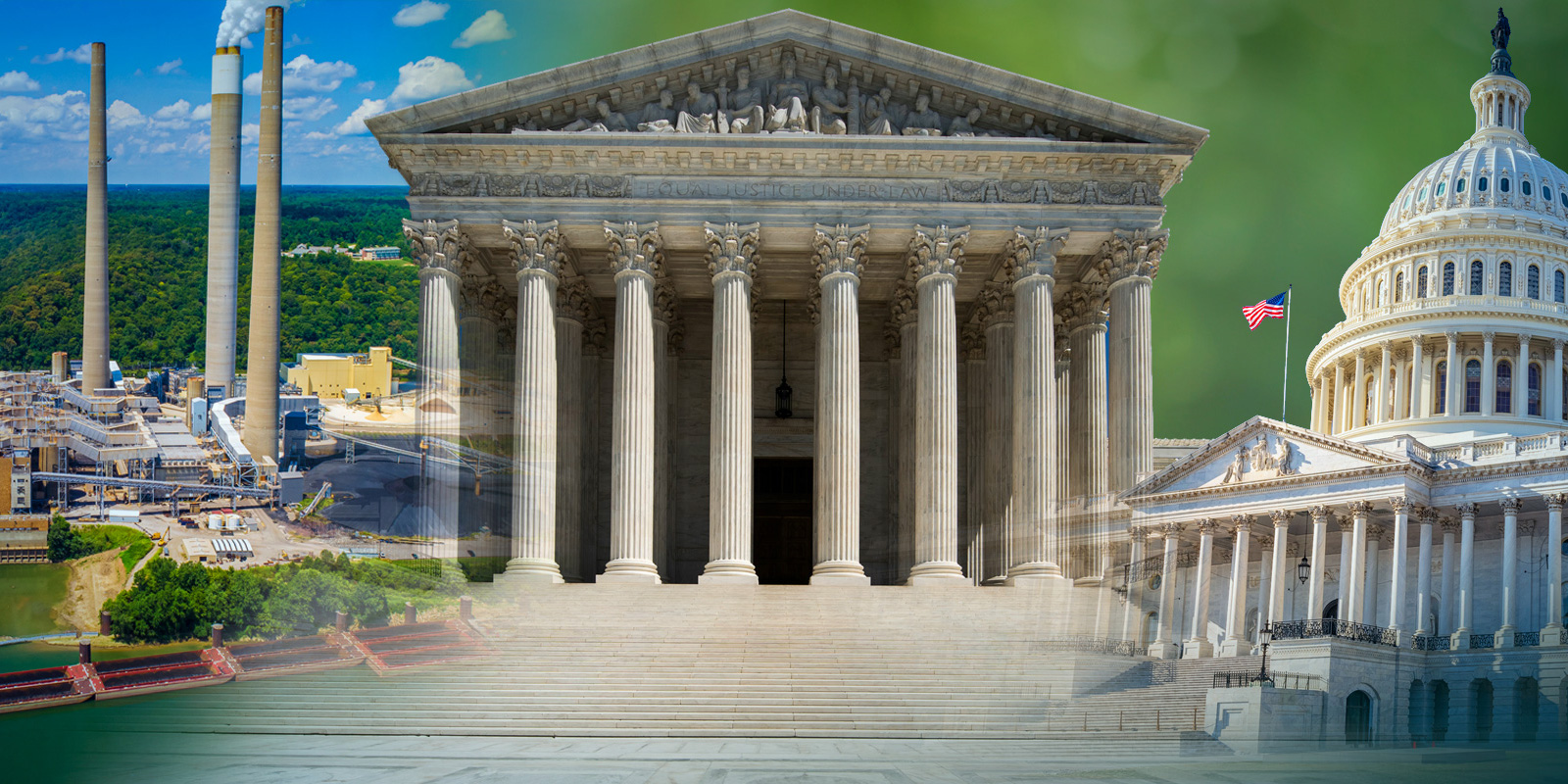
U.S. Supreme Court Curbs Executive Power and Reach of EPA
In Short
The Situation: In 2015, the Environmental Protection Agency (the "EPA") issued the Clean Power Plan (the "Plan") to curb greenhouse gas emissions by forcing power plants to shift from certain energy sources, like coal, to other lower-emitting sources, like wind and solar. The EPA's authority to limit emissions through generation shifting was addressed in a recent U.S. Supreme Court case argued by Jones Day, West Virginia v. EPA.
The Result: In a 6–3 decision, the Supreme Court used the major questions doctrine to determine that Congress did not delegate authority to the EPA to issue the Plan and require existing fossil-fueled power plants to shift generation to lower-emitting sources.
Looking Ahead: West Virginia is likely to have broad implications for executive agency power as the major questions doctrine requires agencies to ground their most significant rules in clear congressional authorization.
What Happened: West Virginia v. EPA
In West Virginia v. EPA, the Supreme Court ruled in favor of Jones Day client, the North American Coal Corporation, and determined that the EPA did not have clear authorization from Congress to curb greenhouse gas emissions from existing power plants through generation shifting. Applying the major questions doctrine, the Court determined that without a clear delegation of power from Congress, the EPA could not deploy a little-used and vague section of the Clean Air Act, Section 111(d), to enact sweeping changes to the energy sector.
In 2015, the EPA issued the Plan, which sought to curb greenhouse gas emissions by forcing existing power plants to reduce their overall carbon emissions by shifting generation to cleaner, lower-carbon-emitting sources such as wind and solar and using existing natural gas generation capacity in lieu of coal. Under Section 111 of the Clean Air Act, the EPA determines the "best system of emission reduction" (or "BSER") that is "adequately demonstrated" and uses it to set guidelines for existing sources of emissions. The Plan established a BSER that existing sources, like coal plants, could not meet by installing cleaner technologies. Instead, the Plan would require plants to reduce their production, shift their generation from coal to natural gas and renewables, or permanently close to meet the new targets.
The Plan trod a twisting path to the Supreme Court that included two D.C. Circuit arguments and an unprecedented stay by the Supreme Court. After the rule was issued in 2015, private parties and states that believed generation shifting was an unauthorized expansion of EPA authority sought review in the D.C. Circuit and requested a stay of the rule. After the D.C. Circuit declined to stay the rule, the Supreme Court stayed it in 2016 pending the completion of judicial review. Later that year, the D.C. Circuit bypassed review by a three-judge panel and held en banc argument, but there was an intervening change in presidential administrations before an opinion could be issued.
The new administration prevailed on the D.C. Circuit to hold the case in abeyance while the administration reconsidered the Plan. The reconsideration led the EPA to rescind the Plan and replace it with the Affordable Clean Energy (the "ACE") rule, concluding that the Plan had exceeded the EPA's statutory authority under Section 111(d). The new ACE Rule repealed the Plan, eschewed generation shifting, and instead established emissions guidelines comprising source-specific equipment upgrades and operating practices. The petitions for review of the Plan that had been pending at the D.C. Circuit were dismissed as moot, to be replaced by petitions from multiple states and private parties, including environmental groups, challenging the ACE rule. A three-judge panel heard argument on those petitions in October 2020.
In January 2021, the D.C. Circuit vacated the ACE rule, including the Plan repeal, effectively reviving the Plan. In the court's view, the "best system of emission reduction" in Section 111(d) could reasonably include generation shifting. It also found that the major questions doctrine did not apply. Thereafter, another change in presidential administrations occurred. After the decision, the EPA secured a partial stay of the court's mandate related to the Plan's repeal so the agency could consider promulgating a new rule. The Supreme Court then granted petitions for certiorari by West Virginia, the North American Coal Corporation, and other parties.
In a 6–3 decision, the Supreme Court found that Congress did not grant the EPA the authority to create emission caps based on generation shifting. Separation of powers principles, as well as a practical understanding of legislative intent, require that an agency exercising broad and transformative regulatory power must have a clear statement from Congress. Section 111(d) of the Clean Air Act provides no such clear authorization. As a result, although the EPA still has the power to determine emission limits through the BSER and can force sources to "operate more cleanly," it cannot force existing sources to shift their generation to lower-emitting sources. Without a clear statement from Congress, restructuring the country's mix of electricity generation was beyond the authority delegated to the EPA by Congress.
Expansion of the Major Questions Doctrine May Limit Chevron Deference
The expansion of the major questions doctrine in West Virginia calls into question the role Chevron deference should play in administrative agencies' interpretations of statutory language. The principles announced in Chevron require courts to defer to an agency's interpretation of an ambiguous statute where the agency's interpretation is reasonable. The major questions doctrine, on the other hand, holds that courts should not defer to an agency's interpretation where questions of "vast economic or political significance" are at issue, even if the agency's interpretation is textually plausible.
As Justice Gorsuch points out in his concurrence in West Virginia, the Supreme Court has applied the major questions doctrine in "all corners of the administrative state," whether the issue at hand involved the FDA's power to regulate tobacco products, the CDC imposing an eviction moratorium, or OSHA's authority to enforce a vaccine mandate. Where the issue is of "deep economic and political significance," Chevron does not provide the appropriate analytical framework, especially where an agency seeks to regulate an area that is not within its realm of expertise. Major questions serve as a check on Chevron, ensuring that executive agencies do not take advantage of statutory ambiguities to assume power far beyond what Congress intended. Indeed, the major questions doctrine preserves the separation of powers and underlines Congress's constitutional role as the appropriate governmental body to take meaningful action on issues of vast economic and political significance.
The Chevron framework played no role in the majority opinion in West Virginia. Instead, the Court centered its analysis on the major questions doctrine, determining that the EPA lacked clear congressional authority to wield the power it purported to find in the Clean Air Act. As such, the West Virginia decision falls into an expanding line of jurisprudence where the major questions doctrine trumps Chevron deference. This growing body of law suggests that the major questions doctrine will serve to limit Chevron's future role in the administrative landscape.
Going Forward: Major Questions Doctrine and Application to Other Agencies
President Biden has set goals for a carbon-free electric grid by 2035 and net-zero emissions for federal operations by 2050. The EPA is still formulating a response to the West Virginia decision, which allows the Agency to adopt a BSER that does not require generation shifting and can be implemented by existing sources. West Virginia also leaves open the possibility of congressional action to give clear direction to the EPA.
We also anticipate a rise in legal challenges to other exercises of executive agency power beyond the EPA and the Clean Air Act, including challenges to the Securities and Exchange Commission's (the "SEC") recently proposed climate-related disclosure rules (the "SEC Proposal"). A comprehensive analysis of the SEC Proposal is detailed in Jones Day's comment letter to the SEC.
The SEC Proposal requires registrants to disclose climate-related information in their registration statements and periodic reports, including information on direct, indirect, and up-and-downstream emissions. However, Congress granted the SEC authority to promulgate regulations to protect investors and the public interest, not to compel registrants to inventory greenhouse gas emissions. The Commission's claim to authority over climate-related information is even more questionable given that Congress delegated authority to the EPA to regulate reporting of climate-related data, including greenhouse gas emissions. The line of major questions doctrine cases, including West Virginia, may make it increasingly difficult for the SEC to rely on an interpretation of an ambiguous statute to authorize the SEC Proposal. Regardless of whether the SEC's interpretation of its statutory authority is a reasonable one, it is possible that the major questions doctrine as articulated in West Virginia precludes the SEC from adopting the SEC Proposal. As stated by Chief Justice Roberts in West Virginia, "Congress intends to make major policy decisions itself, not [to] leave those decisions to agencies."
In West Virginia, the Court made clear that consequential agency decisions must have "more than a merely plausible textual basis for the agency action" and "must point to clear congressional authorization for the power it claims." West Virginia has set the stage for the courts to apply the major questions doctrine beyond the EPA to all federal agency exercises of significant executive power.
Two Key Takeaways
- In West Virginia v. EPA, the Supreme Court solidified its major questions jurisprudence and significantly curbed the EPA's power to regulate greenhouse gas emissions. Without a clear statement from Congress, the EPA did not have the authority to require existing sources to shift generation to lower-emitting sources.
- Future legal challenges to other executive agency action are likely given the Court's requirement of a clear statement rule for an agency to exercise broad, free-ranging authority under the major questions doctrine.



